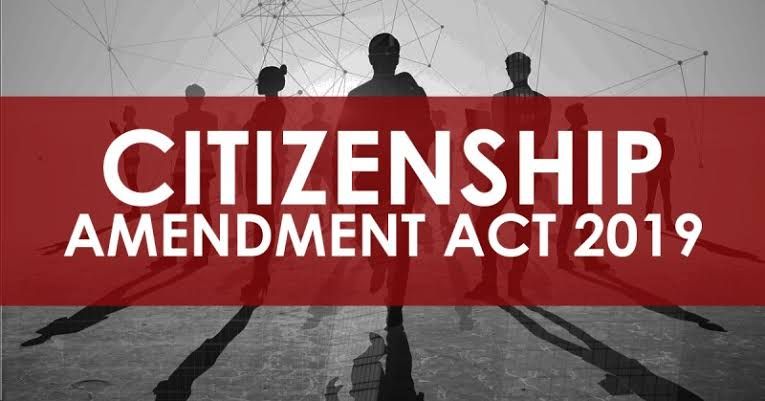Citizenship amendment act 2019

Diksha Tiwri from JIMS ENGINEERING MANAGEMENT TECHNICAL CAMPUS of Law
Introduction
- The Citizenship Amendment Bill was first presented in 2016, amending the Citizenship Act of 1955. Following scrutiny by a Joint Parliamentary Committee, its report was submitted on January 7, 2019.
- Subsequently, the Lok Sabha passed the bill on January 8, 2019, but it lapsed with the dissolution of the 16th Lok Sabha.
- Reintroduced on December 9, 2019, by Home Minister Amit Shah in the 17th Lok Sabha, it was passed on December 10, 2019.
- The Rajya Sabha also approved the bill on December 11th.
- An illegal migrant, as defined by the Act, is someone who either enters the country without proper travel documents such as a passport and visa, or enters with valid documents but overstays beyond the permitted duration.
- Such individuals may face imprisonment or deportation under the Foreigners Act, 1946, and the Passport (Entry into India) Act, 1920.
Citizenship Meaning
- The CAA Outlines the bond between a country and its residents, granting individuals specific entitlements like state protection, voting rights, and eligibility to hold certain public offices in exchange for fulfilling obligations mandated by the state.
Citizenship in India
- The Indian Constitution establishes a unified citizenship for the entire nation, and Parliament holds the authority to legislate on matters related to citizenship, naturalization, and aliens, as outlined in Entry 17 of List 1 under the 7th Schedule.
- Until 1987, birth in India was adequate for Indian citizenship eligibility.
- However, a 2004 amendment stipulated that both parents must be Indian citizens, not just one, for a person to be considered eligible for Indian citizenship by birth.
Features of CAA 2019
- This act aims to facilitate the citizenship process for persecuted individuals from India’s neighboring countries, specifically Afghanistan, Bangladesh, and Pakistan, who belong to Hindu, Sikh, Buddhist, Jain, Parsi, and Christian communities.
- It reduces the naturalization period from 11 years to 5 years for applicants of these specific religions.
- Additionally, it restricts the benefits of Overseas Citizenship of India (OCI) holders, who are foreign citizens of Indian origin, by revoking their privileges if they violate any local laws, regardless of the severity of the offense.
Exception
- This act introduces a provision excluding illegal migrants from applying for citizenship in the regions of Assam, Meghalaya, Mizoram, and Tripura, as these areas are covered by the sixth Schedule of the Indian Constitution.
- These tribal areas encompass Karbi Anglong (in Assam), Garo Hills (in Meghalaya), Chakma District (in Mizoram), and Tripura Tribal Areas District. Furthermore, it does not apply to areas under the Inner Line Permit governed by the Bengal Eastern Frontier Regulation of 1873.
Criticism
- Against Muslims
- This act faced criticism as it specifically targeted the Muslim community . So according to the constitution it will not only be against secularism but also against freedom , liberty , and justice.
- The amendment does not extend the relaxed naturalization requirement to include Shia, Balochi, and Ahmadiyya Muslims in Pakistan, as well as Hazaras in Afghanistan, who also face persecution.
- It is a key argument against CAA that it will not extend to those persecuted in Myanmar and Sri Lanka.
- Reason behind North East People Protest
- In the North eastern states, the possibility of granting citizenship to a large number of undocumented Bangladeshi migrants has sparked significant concerns.
- These concerns include apprehensions about demographic shifts, threats to livelihoods, and the potential erosion of indigenous cultures.
- Additionally, there is an economic aspect to consider. If tens of thousands of individuals leave Bangladesh and legally settle in Assam and the Northeast, the primary economic resource land will likely face significant pressure.
- Political rights also boiling questions were raised at that time.
- Migration in Assam is also a burning question.
- Other issues related to CAA
- CAA does not consider Jew and atheists.
- The rationale behind grouping Afghanistan, Pakistan, and Bangladesh together while excluding other neighboring countries is not clearly defined.
- Critics argue that the provisions of the CAA create an unequal treatment scenario, where individuals deemed “illegal migrants” may be denied equal protection under the law.
- They suggest that the law may grant citizenship to individuals who are perceived as less deserving while excluding those who may have a stronger claim for protection.
- For instance, a Rohingya fleeing persecution in Myanmar may not be considered for citizenship, while a Hindu from Bangladesh, who may be an economic migrant without facing direct persecution, could be entitled to citizenship.
- Similarly, individuals like a Tamil from Jaffna escaping atrocities in Sri Lanka may also be classified as “illegal migrants” without the opportunity to apply for citizenship.
- Additionally, the reduction in the residential requirement for naturalization, from 11 years to five, has not been sufficiently explained or justified according to critics.
Arguments in support
- Not against muslims
- This act is not against muslim as Ahmediyas and Rohingyas still can get Indian Citizenship if they enter India with valid documents .
- If Shia Muslim face harsh treatment on the ground of religion or belief in this case they will continue to reside in India as a refugee .
- Including Balochi refugees in the CAA could be seen as meddling in Pakistan’s domestic matters since Balochistan has a history of striving for independence from Pakistan.
- With respect of North East people
- As with respect to north east people perspective this act does not dilute their Holiness of the Assam Accord .
- As this act is not Assam centric.
- It also applies to the whole nation.This act is not definitely against the National Register of Citizens.
- In other words, individuals belonging to religious minorities who migrate to India after December, 2014, will not be eligible for benefits under the CAA.
Conclusion
- The Supreme Court must assess the CAA constitutionality by reviewing if its classifications are reasonable under Article 14 of the Constitution.
- While India has a moral obligation to shelter those persecuted in neighboring countries, the approach must align with the principles of the Constitution.
- We need to actively involve the people of the North-East and reassure them that their language, culture, and traditions will be protected.




